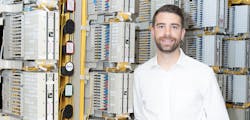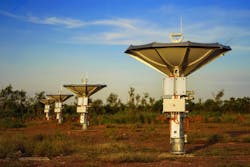Executive Insights with Noah Drake, President, Americas, Telstra
Getting Inside the New Leader’s Priorities and Professional Passions
Topic: The Future
ISE: What emerging or disruptive technology excites you the most for the ICT industry? Why?
Noah Drake, Telstra: We have an ongoing responsibility to our customers to stay ahead of industry trends and keep our networks in a constant state of readiness to support whatever connectivity methods our customers need to carry out their digital initiatives.
One thing we’re excitedly watching close is the development of the next application of the Internet—Web 3.0. The web has evolved from a strictly consumption-based model to Web 2.0, which is what we live with now, to Version 3.0, which is all about the decentralization of the Internet. In Web 3.0, there will be a public and shared cloud environment, but also private cloud environments that companies will use for a variety of purposes. They will need reliable and flexible connectivity allowing them to participate on different levels. So, from an infrastructure perspective, we need to build and maintain our networks to support any potential use case.
Another area where we see explosive growth is the financial technology and capital markets, especially the emerging area of cryptocurrency, for example. There is a continuing global growing interest in crypto among companies, governments, and banks, as more realize its many benefits as an alternative exchange medium to traditional currencies or to purchase goods and services. As this exciting market develops, Telstra will be there to enable the industry as a provider of secure, reliable and low-latency connectivity to crypto exchange environments.
As we did with our Telstra Octagon network platform for capital markets and high-frequency trading, and our GMN or IDN for users who need hybrid delivery and contribution options, the network infrastructure we provide is ready for whatever our customers need.
Topic: Your Professional Passion
ISE: Share one problem/challenge you are passionate about solving for the ICT Industry.
Drake: Plugging the talent gap. We have a problem generating early career talent in the ICT industry and it will be a major problem in the coming years if we don’t take the necessary right-sizing actions now. I’m committed to working with our partners, customers, and even competitors to ensure this is an attractive and exciting space to work. That’s why we are considering some “outside of the box” thinking, looking at programs to broaden the recruitment base and expose our junior employees to strategic projects and executives across the industry at events like trade shows or conferences. We need to be relevant for the next generation if we hope to carry on into the future in a meaningful way.
Topic: Partnerships
ISE: What is the roadmap for Telstra’s additional partnership efforts in the US over the next year?
Drake: To Telstra, “partner” can have many definitions, for example, it can mean fiber network operators or data center operators. Telstra’s goal is to establish strategically complementary partnerships where it makes the most sense for our customers.
Partners have been so important to our earliest expansion efforts in Canada, for example, providing complementary capabilities and assisting us in building talent and providing services to customers in the region.
As we expand into markets like Canada, we will strive to work with the established telecoms and fiber operators already in the Canadian region, to leverage their existing network investments and then build network infrastructure on the edge of those networks. Satellite operators will still need the ground station support that we already operate—another example of forming partnerships to better serve our mutual customers.
No one can do everything themselves, and Telstra places an enormous emphasis on the importance and value of partners across our business. If you stop investing in important partnerships, you risk losing relevance to your customers.
Topic: Submarine Cable Network Challenges
ISE: Share the greatest challenges when upgrading submarine cable capacity. How is network reliability monitored and what is the redundancy plan if something unexpected occurs?
Drake: Designing, laying, and connecting subsea routes across the ocean is a big task on its own, but maintaining them can sometimes prove almost as difficult. Laying cable is a unique beast and an expensive exercise. Some of our cables run thousands of meters underwater, with one cable crossing the Mariana Trench—the deepest water trench in the world. Fixing subsea cables isn’t a quick job. Depending on the location and damage, we will either send out a dive team or use a grappling hook to retrieve the cable for repairs.
But any expense or logistical headaches are well worth it. This network of more than 250,000 miles of fiber optic subsea cable, that we own and operate, is what truly sets us apart, providing the underlying platform for our products and services.
The large scale of our network and ongoing strategic investment to build our subsea footprint creates redundancy options in case the unexpected occurs. Because we have so much redundancy in our subsea cable networks, we can immediately divert traffic to alternative paths so that customers are not impacted.
Topic: Priorities
ISE: What are two of the company’s network-related priorities for 2022?
Drake: Our goal is to focus on where our network assets and geographic footprint will be most relevant to customers, focusing on industries and applications where we have a unique and compelling solution to offer. While the specifics may vary each year, the overall growth drivers remain fairly constant: market and network expansion, broadening our product portfolio and industry specialization.
We plan to continually deepen our unique and diverse portfolio of connectivity options, including subsea fiber, satellite, Internet or a hybrid combination by adding new technologies and forging new partnerships in each area. We’ve already announced our investment in the SX NEXT cable project, we have more satellite-related collaborations in our pipeline and our Global Media Network is reaching new destinations. From a market perspective, look for more growth within Canada, as well as potential expansion in Latin America and other key regions worldwide.
We have an ongoing responsibility to our customers to stay ahead of industry trends and keep our networks in a constant state of readiness to support whatever connectivity methods our customers need to carry out their digital initiatives.
Topic: Labor Challenges
ISE: What are your thoughts about the challenges of attracting and retaining field talent in the future?
Drake: While each type of employee has their own valuable and unique skills, talent development is talent development, whether it’s for the field, headquarters or remote work. It’s more about nurturing each person’s skills and capabilities and that’s on us as the employer.
It is important that we continually reassess and redefine our recruiting efforts, getting ahead of the recruiting effort and making sure we have mentoring programs and networking and development opportunities that are relevant to current employees and even for prospective candidates while they are still in school. Then, once they join us, our responsibility is to do whatever we can to help employees grow, find their voice, and develop their careers on a track that they set, not one we define for them.
Topic: Network-as-a-Service
ISE: How is Telstra planning to leverage this model for the future?
Drake: Online subscription models are part of our daily lives, whether it’s for entertainment, such as a streaming service, or recurring food deliveries. We enjoy the control, the ability to customize and manage these services according to our needs. There’s really no difference now with enterprise network infrastructure and bandwidth.
Thanks to new software-based technologies more suited to today’s adaptive networking needs, organizations are no longer limited to inflexible, costly, and time-consuming options involving monthly service provider contracts and large IT support teams. It’s now possible to meet users’ modern technology expectations and create network infrastructures enabling flexibility, efficiency, lower unit cost and scalability—all while being simple enough for users to manage themselves. They easily scale bandwidth up or down, or for certain time periods, all on a customized network designed to integrate with open-source cloud environments and also built with the latest and most popular applications in mind. Even more impressive is the ability to do this up and down the tech stack.
But this all begins with a shift in mindset and an open attitude to change. The technology world is evolving, and we all need to either adapt or risk becoming irrelevant.
Topic: Secure Access Service Edge (SASE)
ISE: The SASE market is forecast to be $4.1 Billion by 2026, growing 26.4% from 2021-2026. Share Telstra’s plans in this area and a few milestones for 2022. (Source: www.researchandmarkets.com)
Drake: Security considerations are key to deploying any new connectivity foundation to realize network optimization or enhance the end-user experiences, and SASE is a critical element of that approach. For example, one potential challenge with SDWAN is its use of a software networking overlay, which is efficient for connectivity but can lack sufficient security and access controls. SASE can augment an SDWAN network with enhanced security provided as a service and performed at the point where your Internet service comes onto your network at each location before the traffic reaches your centrally orchestrated network. Security at the edge is much more effective and the fact it's decentralized gives people more options for managing their own unique security requirements. That’s why we are incorporating it into our SDWAN offering as standard practice.
We will continue to roll out new technologies within our Adaptive Networks portfolio and SASE will remain a cornerstone of these high-demand technologies. For example, Telstra Adaptive Networks have a SASE architecture that combines network security functions with WAN capabilities to support dynamic, secure access for your business, protecting users and data from cyberthreats.
Topic: 5G and Satellite
ISE: Talk about Telstra’s Satellite offerings and how they impact 5G rollout across the US.
Drake: It’s becoming a more widely held belief that, in many cases, it’s better to view “competition” as potential opportunities. Satellite operators are seizing opportunities to expand their global footprint; however, satellite services still rely on telcos for ground stations and transport, and operators regularly face barriers to market entry. These issues are often best addressed through mutually beneficial partnerships with telcos.
More connectivity benefits everyone, especially as worldwide demand for connectivity is surging to the point where, on some key routes, there's a genuine capacity shortage. It's critical that service providers such as Telstra continually invest in new types of infrastructure. Regardless of which technology is ultimately delivered to the end user, there will always be a need for collaboration. Embracing this reality, rather than fighting it, is the more logical path to long-term success.
But wait, there's more!
Read on for topics not included in print.
Topic: Proactive Network Management
ISE: What are some proactive approaches you recommend to control OPEX?
Drake: OPEX models are critical to an ICT company’s success, especially since many networking services are offered as purely operational and not CAPEX investments. A key indicator of healthy OPEX management lies in network architecture. To guide your network life cycle management, ask yourself these questions:
- Does your company integrate its networks post acquisition? If yes, then does the company also integrate its vendor contracts post acquisition? Both are important for identifying and avoiding redundancies and redirecting misaligned agreements that can put an organization at risk for commercial exposure.
- Does your company have appropriate inter-company usage models to provide end-to-end service in-house? If not, many companies take on unnecessary OPEX due to certain business units or product lines procuring local loops/last mile from the general market because they are more incentivized to do so from a user experience and ROI standpoint.
- Is off-net/access pricing benchmarked and reviewed on a regular basis? If yes, are in-term contracts also reviewed as part of that process? Many companies leave legacy services in place with out-of-date technologies priced at out-of-market rates. This can accumulate to a massive drag on the business.
Topic: Growth and Balance
ISE: Share Telstra’s growth targets and how you plan to ensure your team integrates networks AND employees successfully.
Drake: Our long-term goal is growing the company at the right pace, one that makes sense for our business, customers and employees. It’s not always as important to be the biggest provider, but we do want to be the one customers rely on as a long-term partner.
Topic: Network Sustainability
ISE: What is your company doing across the network to help hit these aggressive sustainability targets?
Drake: Telstra is committed to environmentally conscious activities across its entire range of operations, with a range of initiatives designed to maintain carbon neutrality, reduce supply chain carbon emissions, carbon footprints and make a positive impact on global climate change.
We even recycle our subsea cables where we can, pulling them out of the ocean when they need to be replaced. However, in places where the subsea cable goes through the Great Barrier Reef in Australia, for example, we don't touch it because we don't want to disturb that ecosystem.
We’re proud of the fact that Telstra regularly ranks highly on industry business responsibility and sustainability surveys, and we have several sustainability efforts in place:
- By the end of 2022, all Telstra branded packaging will be made of renewable or recycled material and will be fully recyclable.
- We’re aiming to recycle or reuse over 500,000 phones, modems, and other devices each year to 2025.
- Our goal is to increase our network waste recycling rate to 85% by 2025.
Topic: Retaining and Retraining Top Talent
ISE: Share your thoughts about the “rub” of this reality to employers AND employees.
Drake: As a telecommunications company, we’re constantly focused on investing in our networks to grow revenue. But it’s equally important to ensure we continually invest in our people, too. We can’t begin to talk about attracting and retaining top talent without first addressing workplace culture. Employees want to know they are doing work that makes a difference and truly has an impact on people’s lives. That opportunity not only creates an incredible sense of empowerment, but it’s also a powerful recruiting tool.
Candidates now have more say in deciding where and how they want to work, so the onus is on organizations to reevaluate the type of workplace they want to offer. For our part, we try to offer the best of two worlds, especially when it comes to technology. The network infrastructure and services we provide for customers helps transform the way the world functions. That definitely keeps people going. At the same time, we provide the best and the brightest network and device technology to support our own workforce in their daily jobs, so we're also using what we're selling.
But it’s up to our entire team, starting with leadership, to commit to ongoing learning, training and professional development. That’s how you keep your business relevant, dynamic and thriving.
Topic: DEI
ISE: Explain why cultural transformation is as equally important as technical transformation for ensuring Communications Service Providers (CSPs) thrive in the future.
Drake: Our position is “Diversity, equity, and inclusion (DEI) is for everyone.” It contributes to the success of the entire organization. It is everyone's business, and it is a business imperative for Telstra. DEI is critical for achieving our strategic objectives and it’s important to us that our team is as diverse as the customers and partners we serve all over the world.
To attract the best and brightest people, we are focused on creating an equitable, diverse workplace. But diversity is only diverse when everyone is involved. The value in having a diverse pool of people across the business brings different perspectives, different insights, different ways of thinking about things and different ways of breaking down problems. Diversity and our culture are two factors that can help to encourage a new generation of telco professionals as we look to grow and nurture new graduates entering the workforce.
Continually enhancing our DEI efforts ranges from reevaluating how job descriptions are written, to ensuring the right mentoring and career development support systems are in place, to redefining success for every employee. Actively supporting, promoting and investing in talent is the best way to help build the next generation of leaders.
ABOUT NOAH DRAKE
Noah is responsible for sales, business operations, further expanding Telstra’s portfolio of technology solutions, continuing to accelerate strategic partnerships, and leading the company’s future direction within the region. He has a diverse and successful background in telecommunications leadership. Most recently, he led Telstra’s Customer Solutions and Architecture group, directing a specialized team of professionals working with customers to harness the full capabilities of Telstra’s products and services. For more on Telstra, visit www.telstra.com/americas. Follow them on Twitter @TelstraEnt and LinkedIn: showcase/telstra-enterprise.
About the Author
Sharon Vollman
Content Ambassador for ISE EXPO
Sharon Vollman is the Content Ambassador for ISE EXPO. She is passionate about collaborating with thought leaders, SMEs and hard-working doers who design, plan and deploy ultra-reliable broadband networks. Vollman is committed to creating a variety of educational offerings for ISE EXPO attendees that inspire them to connect every U.S. citizen with the broadband networks we all want for our children and grandchildren.
Vollman has created educational partnerships with Broadband Service Providers including AT&T, Verizon, Lumen, Frontier Communications and others. She has covered the telecom industry since 1996.




